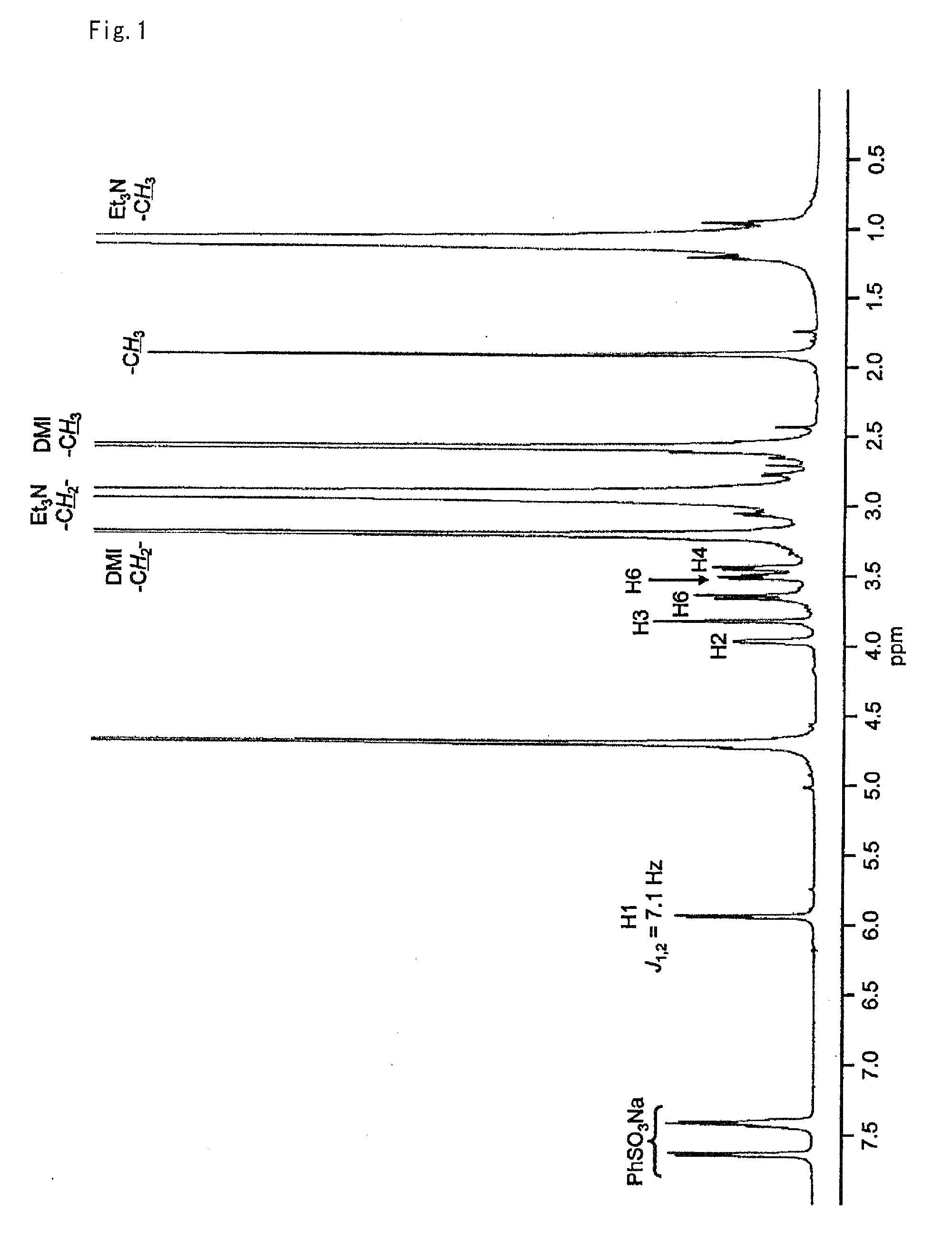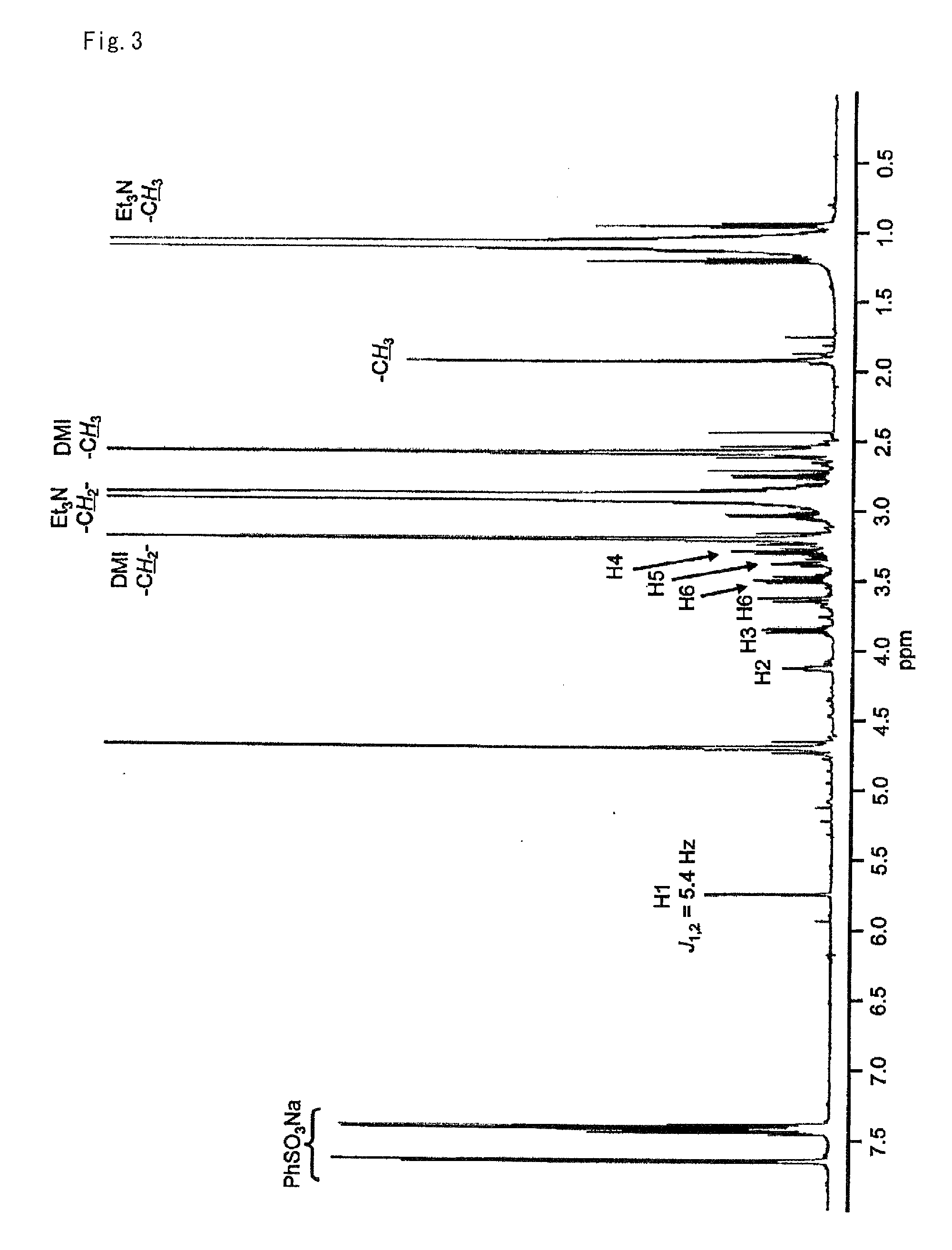Method for production of sugar oxazoline derivative
a technology of sugar oxazoline and oxazoline derivative, which is applied in the direction of anti-inflammatory agents, drug compositions, immunological disorders, etc., can solve the problems of difficult synthesis of oxazoline derivatives of oligosaccharides, difficult to achieve, and rarely performed today
- Summary
- Abstract
- Description
- Claims
- Application Information
AI Technical Summary
Benefits of technology
Problems solved by technology
Method used
Image
Examples
working example 1
[0081]To 83.9 mg (0.496 mmol) of 2-chloro-1,3-dimethylimidazolinium chloride was added 27.7 mg (0.125 mmol) of N-acetylglucosamine, 208 μL (1.50 mmol) of triethylamine, and 500 μL of deuterated water (heavy water) and the resultant mixture was stirred for one hour at room temperature. When this reaction solution was analyzed by NMR it was verified that an N-acetylglucosamine oxazoline derivative of the following formula:
was obtained (yield: 83%).
[0082]The yield of the target compound was calculated from the area ratio of the 1H-NMR spectrum after adding sodium benzenesulfonate to the reaction solution as a reference standard. FIG. 1 shows the 1H-NMR spectrum and FIG. 2 shows the 13C-NMR spectrum of the reaction solution containing the target compound.
working example 2
[0083]To 41.6 mg (0.246 mmol) of 2-chloro-1,3-dimethylimidazolinium chloride was added 5.5 mg (24.9 μmol) of N-acetylmannosamine, 104 μL (0.750 mmol) of triethylamine, and 500 μL of deuterated water and the resultant mixture was stirred for one hour at room temperature. When this reaction solution was analyzed by NMR, it was verified that an N-acetylmannosamine oxazoline derivative of the following formula:
was obtained (yield: 76%).
[0084]The yield of the target compound was calculated from the area ratio of the 1H-NMR spectrum after adding sodium benzenesulfonate to the reaction solution as a reference standard. FIG. 3 shows the 1H-NMR spectrum and FIG. 4 shows the 13C-NMR spectrum of the reaction solution containing the target compound.
working example 3
[0085]To 42.2 mg (0.250 mmol) of 2-chloro-1,3-dimethylimidazolinium chloride was added 10.4 mg (24.5 μmol) of N,N′-diacetylchitobiose, 104 μL (0.750 mmol) of triethylamine, and 500 μL of deuterated water and the resultant mixture was stirred for one hour at room temperature. When this reaction solution was analyzed by NMR, it was verified that an N,N′-diacetylchitobiose oxazoline derivative of the following formula:
was obtained (yield: 77%).
[0086]The yield of the target compound was calculated from the area ratio of the 1H-NMR spectrum after adding sodium benzenesulfonate to the reaction solution as a reference standard. FIG. 5 shows the 1H-NMR spectrum and FIG. 6 shows the 13C-NMR spectrum of the reaction solution containing the target compound.
PUM
 Login to View More
Login to View More Abstract
Description
Claims
Application Information
 Login to View More
Login to View More - R&D
- Intellectual Property
- Life Sciences
- Materials
- Tech Scout
- Unparalleled Data Quality
- Higher Quality Content
- 60% Fewer Hallucinations
Browse by: Latest US Patents, China's latest patents, Technical Efficacy Thesaurus, Application Domain, Technology Topic, Popular Technical Reports.
© 2025 PatSnap. All rights reserved.Legal|Privacy policy|Modern Slavery Act Transparency Statement|Sitemap|About US| Contact US: help@patsnap.com



